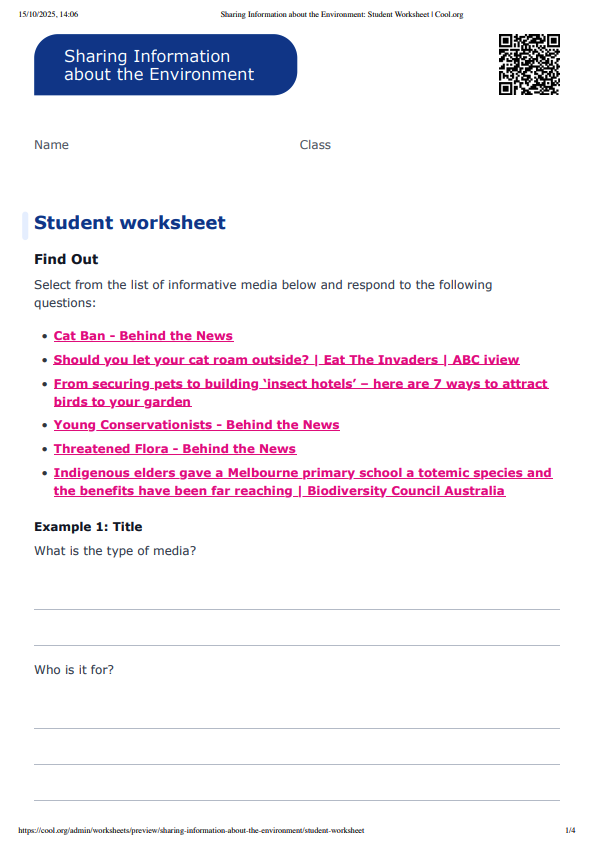Lesson summary
Students will examine how both positive and negative messages about biodiversity are conveyed by analysing a variety of informative texts and identifying the language features used.
Learning intentions
Students will:
- reflect on the importance of sharing biodiversity information
- examine how example informative texts use language features and/or images to convey a message.
Success criteria
Students can:
- explore biodiversity disrupters and supporters
- assess the effectiveness of informative texts.
Lesson guides and printables
Lesson details
Skills
This lesson is designed to build students’ competencies in the following skills:
- critical thinking
- communication
- digital literacy
- global citizenship
- reflection
Curriculum Mapping
Australian Curriculum (v9.0) content description:
Year 3, Science
Students learn to:
- compare characteristics of living and non-living things and examine the differences between the life cycles of plants and animals (AC9S3U01).
Year 3, English
Students learn to:
- identify the audience and purpose of imaginative, informative and persuasive texts through their use of language features and/or images (AC9E3LY03)
- recognise how texts can be created for similar purposes but different audiences (AC9E3LY01).
Year 4, Science
Students learn to:
- explain the roles and interactions of consumers, producers and decomposers within a habitat and how food chains represent feeding relationships (AC9S4U01).
Year 4, English
Students learn to:
- identify the characteristic features used in imaginative, informative and persuasive texts to meet the purpose of the text (AC9E4LY03).
Relevant parts of Year 3 Science achievement standards: Students classify and compare living and non-living things and different life cycles.
Relevant parts of Year 3 English achievement standards: Students read, view and comprehend texts, recognising their purpose and audience.
Relevant parts of Year 4 Science achievement standards: Students identify the roles of organisms in a habitat and construct food chains.
Relevant parts of Year 4 English achievement standards: Students describe the characteristic features of different text structures.
NSW Syllabus outcomes: Stage 2
A student:
- reads and comprehends texts for wide purposes using knowledge of text structures and language, and by monitoring comprehension (EN2-RECOM-01)
- compares features and characteristics of living and non-living things (ST2-4LW-S).
General capabilities: Critical and Creative Thinking, Digital Literacy, Literacy
Cross-curriculum priority: Sustainability
Level of teacher scaffolding: Low - guide discussions and support understandings
UN Sustainable Development Goals
Target 4.7: By 2030, ensure that all learners acquire the knowledge and skills needed to promote sustainable development, including, among others, through education for sustainable development and sustainable lifestyles, human rights, gender equality, promotion of a culture of peace and non-violence, global citizenship and appreciation of cultural diversity and of culture’s contribution to sustainable development.
Resources Required
- digital devices for research
- poster paper
- sticky notes
- Student Worksheet
Additional Info
This lesson was created in collaboration with The Biodiversity Council.
Special thanks to our content partner, The Conversation and to The Garry White Foundation, The Hugh D. T. Williamson Foundation, Wedgetail and The James Kirby Foundation for their generous financial support.
Related Professional Learning
What Makes a Species ‘Threatened’? Teaching Biodiversity and Species Protection
Quick summary: Learn about biodiversity and threatened species with Ecologist Thomas Nixon. You will learn what biodiversity is and how it is regulated in Australia, and you will look at some specific case studies that show what is being done across the country to protect our unique biodiversity.



Welcome back!
Don't have an account yet?
Log in with:
Create your free Cool.org account.
Many of our resources are free, with an option to upgrade to Cool+ for premium content.
Already have an account?
Sign up with:
By signing up you accept Cool.org's Terms and Conditions(Opens in new tab) and Privacy Policy(Opens in new tab).